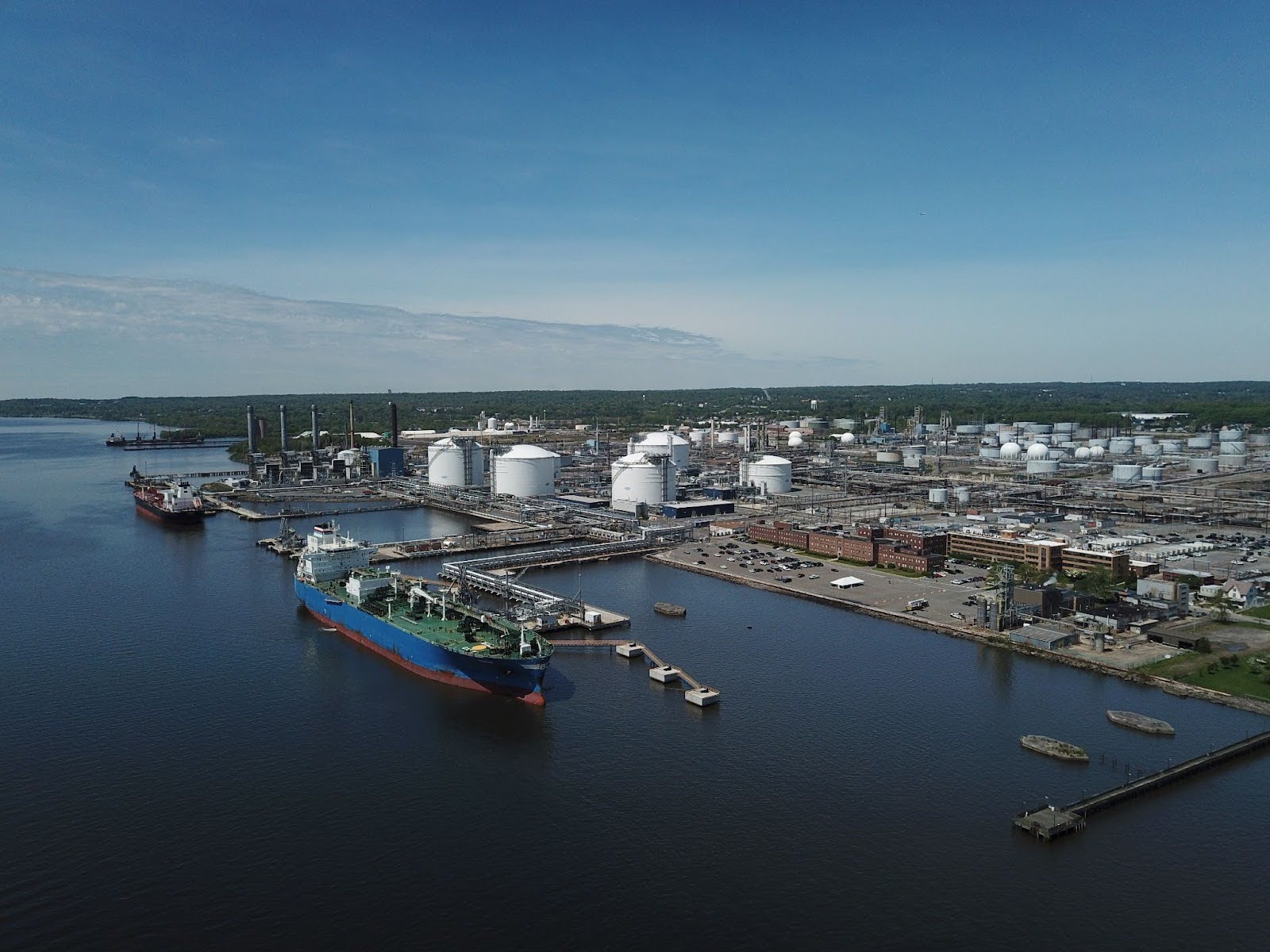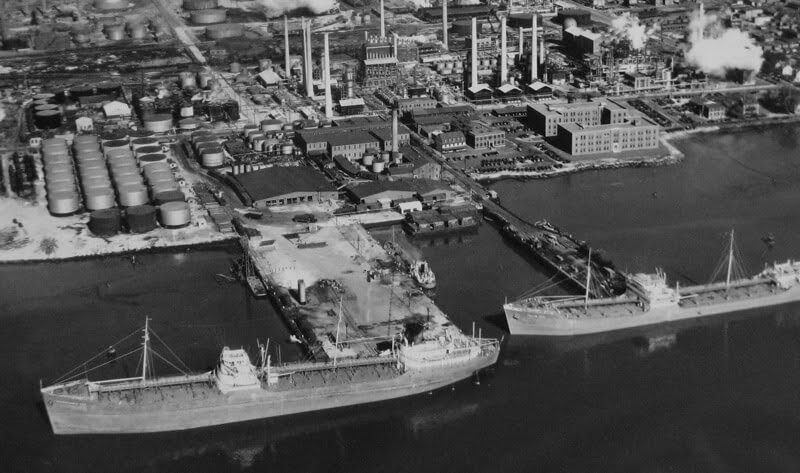Marcus Hook: Lifeline from a Pipeline
AboutThe impact of increased production of natural gas in Pennsylvania can be seen in the changing skyline of Marcus Hook. Thousands of workers are reshaping the former Sunoco oil refinery on the banks of the Delaware River. Energy Transfer’s Marcus Hook Terminal is quickly becoming the premier hub for natural gas liquids on the East Coast, made possible by the Mariner East pipeline system safely delivering the energy that drives our nation and fuels our everyday lives.
To achieve this, our facility has built new processing units, including an ethane/propane splitter and ethane and propane chilling and refrigerated storage. Going back to 2013, we have built six tanks storing approximately 3 million barrels of propane, ethane and butane to support our Mariner East pipeline system, in addition to existing storage capacity of 2 million barrels in underground caverns.
Energy Transfer has also built a fractionator at the facility to process natural gas liquids that it will transport along the Mariner East pipeline system from western Pennsylvania.
Improvements at the facility have required nearly 9 million man hours, involving more than 5,000 individual workers. The facility began receiving propane in January 2015, and it ships propane and ethane for distribution to local, regional and international markets. The facility commissioned a first-of-its-kind ethane truck-loading rack to complement its existing terminal that supplies propane for local and regional delivery.
Ethane Chilling Expansion will help Meet Regional and Global Demand
MHT plays a significant role in processing, storing and distributing the products and resources we rely on for our everyday lives. Energy Transfer is seeking to expand its ethane chilling capacity at MHT.
The project spearheaded by Energy Transfer Marketing & Terminals (ETMT) will add processing equipment to the terminal to increase the existing ethane chilling capacity. It will not expand the facility’s footprint. This project will generate nearly 100 construction jobs at MHT benefit the local economy, and have very little impact on the environment.
Allowing for additional ethane chilling capacity at our terminal will help meet regional and global demand for ethane, which is a building block of many essential items we depend upon every day.
Economic Impact
In April 2019, Energy Transfer announced a project labor agreement with the Philadelphia Building Trades, an association of some 50 local unions, for work at MHT. The two-year, $200 million agreement created 1,200 jobs.
Seasonally dependent, approximately 200 trucks per day pick up propane for delivery to markets in and around Pennsylvania. In fact, more than 90% of the propane sold from the Marcus Hook truck racks stays in the four-state region of Pennsylvania, Delaware, New Jersey and Maryland.
There are other industries benefiting from the revitalization at MHTl, including maritime-related jobs such as ship agents, cargo surveyors, tug assists, ship chandlers and launch companies.
In Nov. 2018, the team at MHT was presented with the Top Gold Star ZISA Award for more than 2 million injury-free hours on the Mariner East project. The award was presented by the National Maintenance Agreements Policy Committee (NMAPC) to everyone who made this achievement possible: Energy Transfer, Nooter Construction and the Philadelphia Building Trades. This amazing number of hours was a record breaker on NMAPC charts and was presented at the Zero Injury Safety Award (ZISA) gala.
The History
The Marcus Hook Terminal, formerly the Marcus Hook Refinery, was built in 1902 on an 82-acreplot purchased by Joseph Newton Pew’s Sun Oil Co. Initially dedicated exclusively to the processing of light sweet crude oil found in Texas, it became highly advanced in the field for petroleum production. In fact, March 2022 marked 120 years since the first crude oil shipment at Marcus Hook.
In 1937 the first catalytic cracker went into operation, enabling the facility to process 15,000 barrels of petroleum daily. During World War II, Sun Oil Co. employees at Marcus Hook processed more jet fuel for the Allies than any other refinery.
Nine times during 1942 and 1943, tankers of the Sun Oil fleet were struck by U-boat attacks, and four were sunk. Those encounters cost the lives of 141 Sun seamen, and in 1949 a statue was erected to honor those lives. It still stands today at the entrance of our facility. The attacks, while devastating, did not prevent the Sun fleet from shipping more than 41 million barrels of petroleum over 2.3 million miles of ocean during the war. As an operating refinery at its height under Sunoco Inc., the refinery processed 175,000 barrels of crude oil per day. In perspective, that is equivalent to filling 252,000 cars with gasoline, 1,500 flights from Philadelphia International Airport with jet fuel or 300,000 homes with heating oil.
The Caverns
Marcus Hook is home to one of the largest underground fuel storage facilities on the East Coast. Hundreds of feet below-ground at the Energy Transfer Marcus Hook Terminal lie five caverns storing butane, propane and propylene.
Built beginning in the late 1950s, four of them are still owned and operated by Energy Transfer, while the propylene cavern is now owned and operated by our Marcus Hook neighbor, Braskem.
After propane and butane reach Marcus Hook through the Mariner East pipeline system, the caverns are used as a safe, cost-effective way to store the product until it is ultimately delivered to consumers locally, regionally and overseas.
A team of Energy Transfer engineers supports the caverns’ daily operation, maintenance and equipment reliability through various safety checks. Deep-well pumps are used to pump the product to a surge drum located at the surface. The surge drum is used to remove water, and transfer pumps are then used to pump the product to its delivery destination – which can include domestic truck racks, pipelines, ships and railcars.
‘Shale-lelujah’
The next several years were marked by dozens of headlines touting the economic revitalization brought by the Marcus Hook Terminal, including the creation of hundreds of new jobs and the economic injection of a new workforce in the Delaware County region.






